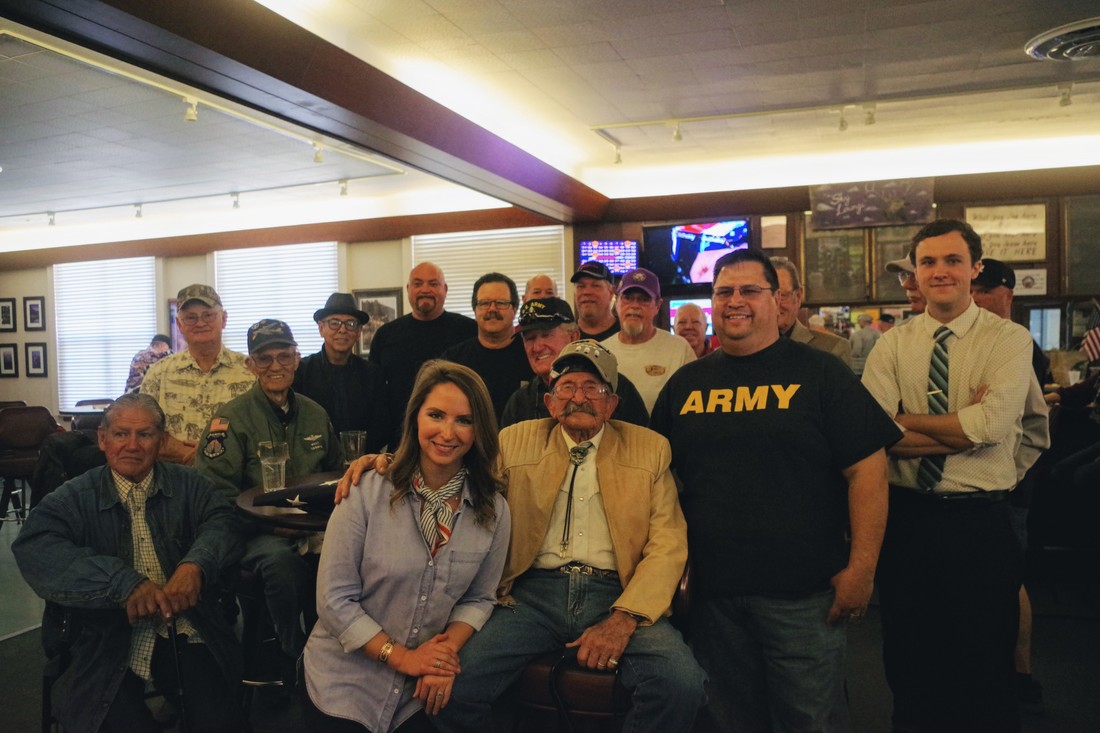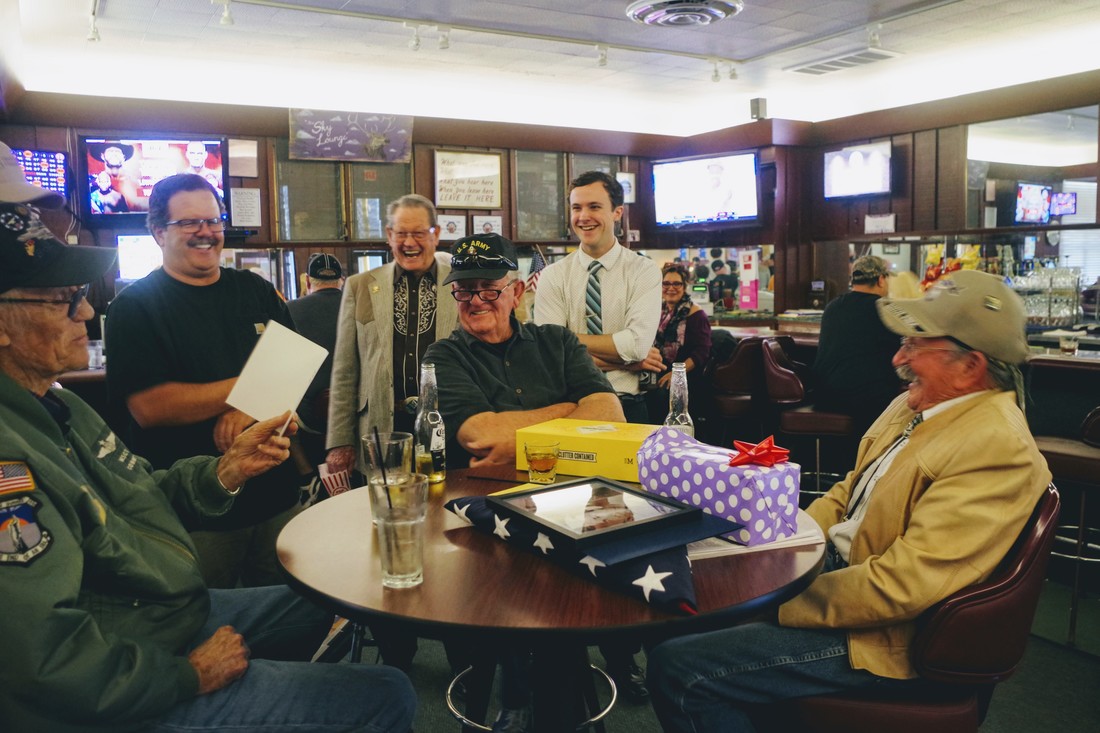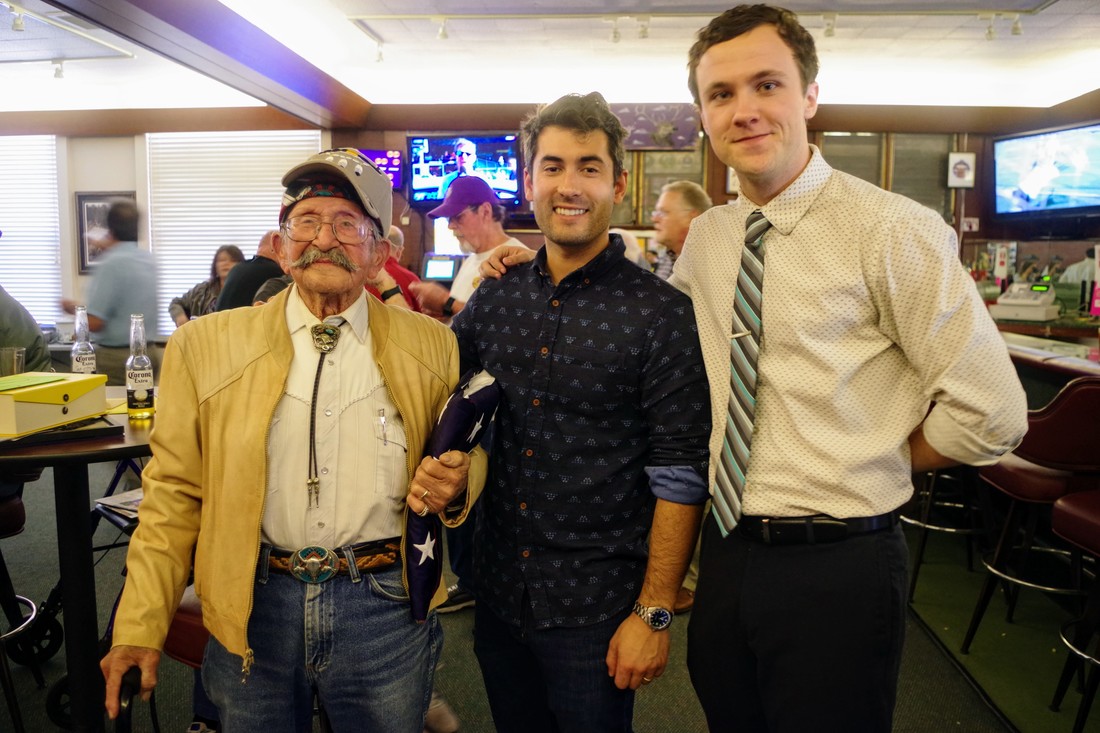At 98, local WWII veteran wishes for a Purple Heart (as published in the Merced County Times2/18/2018  It’s not often these days that one can hear stories of survival, heroism, and grit from a World World II hero firsthand. I wasn’t expecting to meet this distinguished veteran, much less, spend a few hours with him while his friends and I listened to him sharing detailed accounts of his youth, his wartime experience, and the brutal realities of battle. Nor did I expect that on a typical Sunday afternoon, I would make lasting friends that would deepen my appreciation for our country. His name is Frank Paredes, and he is a true American hero. He fought back during the attack on Pearl Harbor, and served our country through the war until December 1945. He fought in 15 campaigns, and was wounded three times. The Atwater resident turns 98 years old this Thursday, Feb. 15. Incredibly, he reveals that he has never received a Purple Heart, a U.S. military decoration awarded in the name of the President to those wounded or killed while serving. His buddies want to change that. They’re fighting for the national recognition in a community effort. It’s easy to understand why when the stories are told. Pearl Harbor It was December 1941 when a young man from an Arizona reservation was making a stop in Hawaii on his way to the Philippines for his first assignment in the Army. Frank Paredes said an early goodnight to his friend that he was visiting from home who was stationed there, so that he could awake early to assist the Father for mass at 8 a.m. the next morning. As he walked to the chapel on a crisp, sunny winter morning, he had no idea he would partake in one of America's most pivotal days in history. At five minutes to 8 a.m. he heard a rumble, followed by, “ATTENTION: THIS IS NOT A DRILL, THIS IS NOT A DRILL. WE ARE BEING ATTACKED BY THE JAPANESE. ALL PERSONNEL REPORT TO YOUR POST.” While Frank might not have had an official post in Hawaii, he would be one of the first Americans to respond to the attack of the Japanese on Pearl Harbor on Dec. 7, 1941. “I didn’t have a post. I manned the first machine gun that I could find. I saw a plane coming, he was maybe 100ft up in the air, so close that I could see the pilot. I took at a burst at him and missed him. The next one I saw, I gave him a lead, took a burst, the second burst was right on. I smoked him. After that, I burned about four or five barrels on the machine guns. I kept on firing as long as I could. When everything slowed down, I went in to start picking up bodies, getting guys medics, fighting fires, helping as much as I could. I picked up about seven guys and put them out of the line of fire so they could get picked up by medics. Following that, I joined those that could get on a bus and we went into Pearl and started picking up bodies, parts of bodies, it was horrible.” Young Forrest Frank is a native of the Dragoon Mountains in Arizona, a member of the Mescalero Apache tribe, and one of sixteen children. Known as “Red Feather” on the reservation, he had a childhood full of interesting stories. For instance, his mode of transportation to school was a donkey, which at one point was stolen by a school bully, and his tomboy sister ended up retrieving the donkey after teaching the kid a thing or two about taking a donkey that didn’t belong to him. He grew up with the famous code talkers of WWI and also knew the Alamo Scouts. Frank volunteered for the Army in September 1941. Ironically, he was drafted by the Army in the spring of 1942 after he had already fought in one of America’s most historical battles, and while he was currently serving in Japan. He was 21 when he enlisted, “I was an old man already! I didn’t know what to do, it was during the depression. I worked in the mines in Arizona for seventy-five cents an hour and it was no good. I needed to do something better than that. Before I enlisted, I hooked onto a tuna boat in San Pedro where we went to Peru. We fished for albacore tuna for four weeks and I made seven thousand dollars. That was a lot of money then! Following that, I chauffeured for Bing Crosby’s kids, Gary & Lindsay, in Monterey, and took Bob Hope on a fishing trip.” After sharing these stories, Frank’s friend, Kenneth Henn, quips, “this guy is like Forrest Gump.” Remarkably, as a boy, Frank used to ride horses on the reservation with another kid named Ira Hayes. Later in life, Ira would be one of the men to raise the second American flag at Iwo Jima which was so famously captured in photographs. Coincidentally, Frank’s brother, Raul, was with Ira that day and was with the group that raised the first flag, but the original flag was too small so the second one had to be raised. First Flight Like many young men and women enlisting in the services, they have no idea where their journey will take them. Frank was up for the task and often said “yes” to daring missions. Frank was stationed in Kearns, Australia, where he took part in missions at New Guinea. “I made half a mission with the Air Force at Kearns, Australia because the Air Force needed gunners. I volunteered as a gunner on a B-25. I told them that they would need to brief me because I’ve never been on a plane before. I volunteered in the army to do what I had to do.” Even if that meant taking his first airplane flight as a gunner for the military! “We went on a mission and were shot down over New Guinea. We were in the shark-infested waters for a couple of hours before we were saved. We deployed sulfur shark repellent to keep them at bay. In about two hours, we were picked up by a PT boat (similar to the kind that President Kennedy piloted) and they took us back to Kearns.” Missing in Action On a mission in the Pacific, Frank and his unit were spotted by the Japanese who shot and hit their boat around 11:30 p.m. The unit worked quickly after being hit; they dismantled the machine guns, put on their life jackets, and sunk their boat. They swam all night to escape being captured and hit the beach by dawn, where Frank covered up their tracks behind them. There, they covered themselves up with palm leaves and bedded down. “Coincidentally, My mom had sent me a watch for my birthday. I had it on while we were hiding, and I could hear the watch ticking.” He took it off, wrapped it up in palm leaves, and buried it in a hole where he would remember to grab it later. “The Japanese never found us. About four days later in the morning after sleeping, I felt something on my throat. I thought, ‘uh-oh, they got us.’ It was a native and he found us.” The native spoke Pidgin English and so they were able to communicate together and tell him that they were Americans. “We followed him and he took us into a cave and he said, ‘we take you to Australian lines.’” Before they left for the Australian lines, Frank grabbed his watch which he has to this day, and it still works. It took them three and a half months to get to the Australian lines. “Once we got there, the Australians told us they were waiting for a bonsai attack. The Australian lieutenant asked me, ‘do you know how to operate a 20mm?’ I said, ‘no, sir, but I can learn fast.’ So he showed me what to do. We got a bonsai attack that night and I operated a 20mm like a pro. Then we got reinforcements and we successfully defended the line. After that was over, they took us to the Australian medics. I thought that maybe it would be our trip home, but no way! We were sent back to the US lines.” His Next Battle The realities of war are not glamorous. “I’m not proud of it [meaning the casualties that came along with war], but I had to do it and am proud to have served our country,” Frank says. “And now I’m fighting for my records.” Unfortunately, all of his military papers were burned along with several others in a fire at the National Hall of Records in St. Louis in 1973. The horrid fire wiped out the records of those that served in the Army and Air Force. The National Archives state that the fire wiped out 80 percent of Army paperwork from those that served from November 1912 to January 1960. According to the National Archives, “No duplicate copies of these records were ever maintained, nor were microfilm copies produced ... a complete listing of the records that were lost is not available." This has been a bit of a stumbling block for Frank in regards to receiving a Purple Heart for his valiant efforts. Today, his biggest challenge is a burden that members of the Elks community have taken on. Wil Hunter, a committed member of the Merced County community and US Army veteran, took it upon himself to start the process of obtaining three Purple Hearts for Frank (for his three WWII injuries). In May 2017, Wil sent a letter to President Trump requesting his attention on this matter to grant Frank a Purple Heart. This request has not been resolved and it is still the focus of many in Frank’s life to get him the recognition he deserves from the United States for his dedicated service in fighting through fifteen campaigns and suffering three wounds in action. Helping Frank in this process is important to Wil; “I got involved because not many 98-year-olds have fought in fifteen campaigns and served like he has; he should get at least one purple heart. It’s something that’s owed to him.” It’s Wil’s request that President Trump personally present the Purple Hearts to Frank in Washington D.C. Frank recently traveled to our nation’s Capitol for the Central Valley Honor Flight, and can still easily travel around at his age. Being 98 doesn’t slow Frank down. He’s an active member of the Merced County community, serving as Bugler for the Merced County Honor Guard and a member of the Merced Elks Lodge. Frank is at the lodge most days of the week to help out and spend time with members of the community, but you can usually catch him assisting with the Elks popular game of Bingo on Tuesday nights. He participates in most of the Merced County veterans events, After spending several hours hearing just a portion of Frank’s stories, it’s hard to find a way to end this article for a man that has a lifetime of incredible stories, but I can think of no better way to wrap it up than to say a hearty ‘thank you’ to Frank. We are fortunate to have an American hero like him in our community. If you ever have the opportunity to speak to Frank, I encourage you to ask him about his experiences in the war. His memory of each of these accounts is remarkable. More than that, if you can help support Frank in his quest to become a Purple Heart recipient, it would be greatly appreciated. Community Effort A new movement called #iammerced was just launched at the State of the City, and I can think of no better way to be Merced County proud than by an entire community getting together to help a local hero receive one of the nation’s greatest honors. If you want to help, use your social media outlet (Facebook, Twitter, Instagram) to ask President Trump to present Frank the Purple Hearts that are owed to him. Instructions: Tag @PresidentTrump and @usarmy and use the hashtags #iammerced and #purpleheartsforfrank along with your personalized message. You can also email the White House at https://www.whitehouse.gov/contact/ or send a letter to 1600 Pennsylvania Ave NV, Washington DC, 20500. Thank you! The chatter that I heard about Frank on that November afternoon was heartwarming and uplifting. Frank was surrounded by his friends that were sharing their true love and admiration for him. Wil Hunter simply described him as a “jewel of a man.” Ken Henn said, “This man has done more in his life than one hundred people.” Kenn Working added, “He’s a living hero.” To which Frank responded, “I’m not a hero. The heroes are the ones that were left behind. I just did what I had to do.” Happy Birthday to you, Frank, for “doing what you had to do” was one of the most important jobs in the twentieth century, keeping our country safe from great evils so that we could live in freedom. If you can provide any support in helping us to get Frank the Purple Hearts that he deserves, please reach Sara Cribari Hill at [email protected]
1 Comment
Ann Kelley
9/9/2019 05:41:17 am
Love this story of Frank.
Reply
Leave a Reply. |


